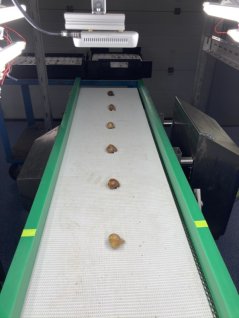
News
Sorting flower bulbs using vision technology and deep learning
After flower bulbs are harvested they are peeled, sorted and checked on defects. Peeling and sorting the bulbs can cause damage to the bulb, affecting the quality of the product. In addition, some bulbs are missed during the manual quality control and end up in the wrong class. The Business Unit Greenhouse Horticulture & Flower Bulbs of Wageningen University & Research is investigating if vision technology and deep learning can be used to determine the volume of bulbs and select bulbs with defects.
After flower bulbs are harvested, a few processing steps are done before the bulbs are packed. The first step is to remove clods and old roots, called peeling. They are first cleared of the clods and then peeled. The bulbs then end up on a sieve, where large bulbs are separated from small ones. However, errors are possible: for example, oval shaped small bulbs can sometimes end up in the wrong class. As a result, a tulip grower (the buyer of the bulb grower) can get batches that are not uniform and therefore flower unevenly.
WUR investigated whether the volume and size of a bulb can be properly determined with a 3D camera. Several hundred bulbs were selected for the 3D camera measurements. and the results were compared with a manual volume measurement by immersion. This showed that the volume measurement with the 3D camera compared to the manual measurements was very good (correlation of 0.92).

The 3D camera was used in combination with deep learning as well to investigate whether the quality could be determined based on camera images. The neural network checks whether the flower bulb has been peeled properly, is damaged or not and whether the skin quality is good. Bulbs with those defects are sold as lower class products. In addition, a damaged bulb is more sensitive to contamination with fusarium.
These measurements showed that the volume / size and selecting "defective" flower bulbs was possible using a 3D camera. In 2021, WUR will investigate whether this is also possible with larger volumes: can the camera and deep learning still keep up?
The research took place in the context of Bulb Revolution 4.0. The implementation of this Public-Private Partnership lies with a consortium of seven partners. These are: KAVB, Anthos, Wageningen University & Research (WUR), Cremer Speciaalmachines B.V., Machinefabriek Steketee B.V., Agrisim B.V., BKD and TechNature B.V. Economic Board Greenport Duin & Bollenstreek and Rabobank Bollenstreek contribute to the financing from their Innovation Funds.